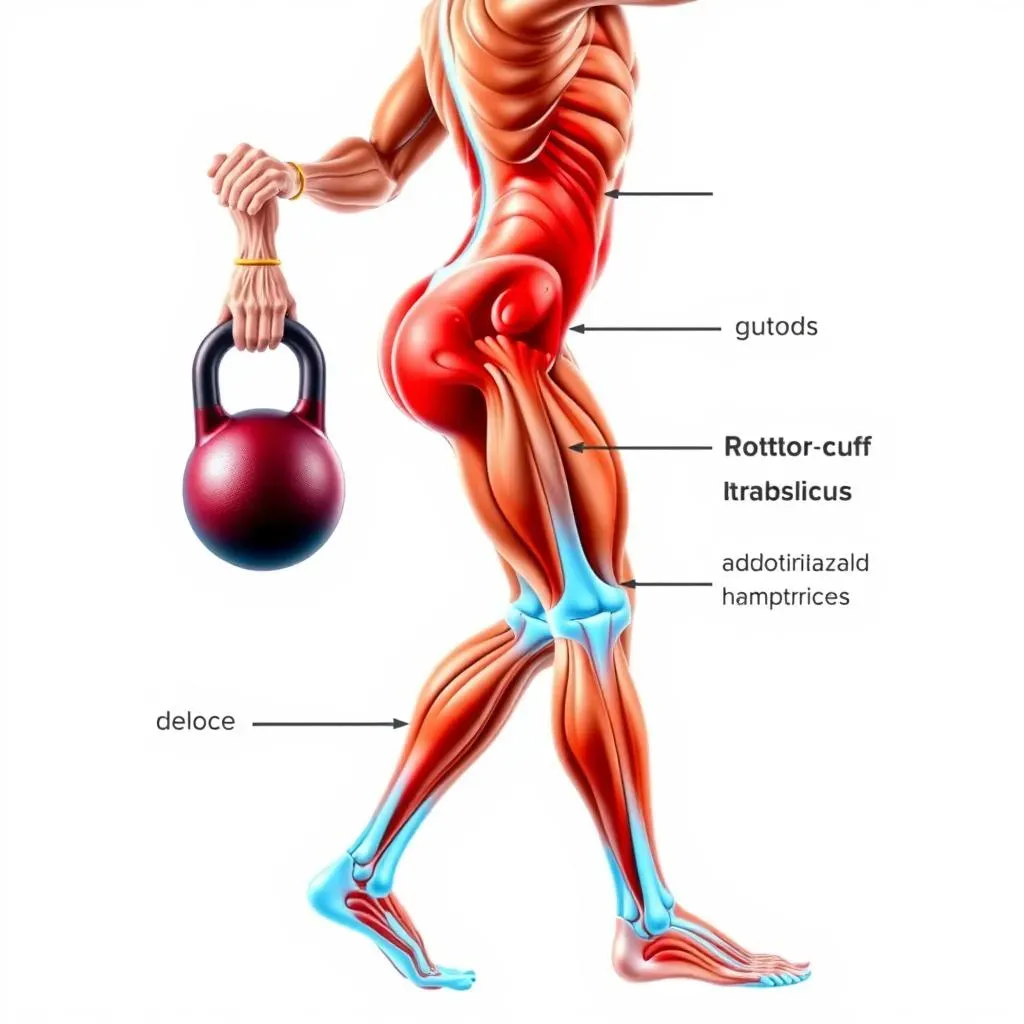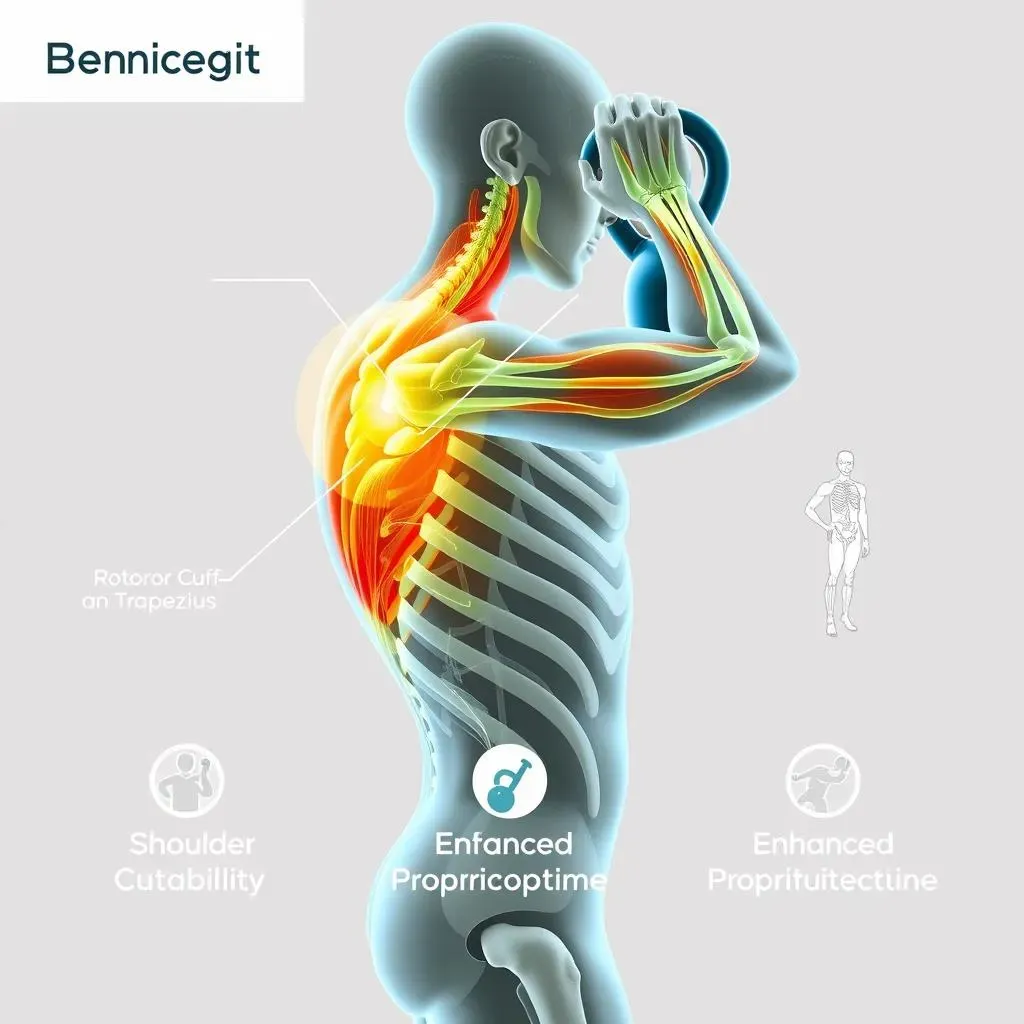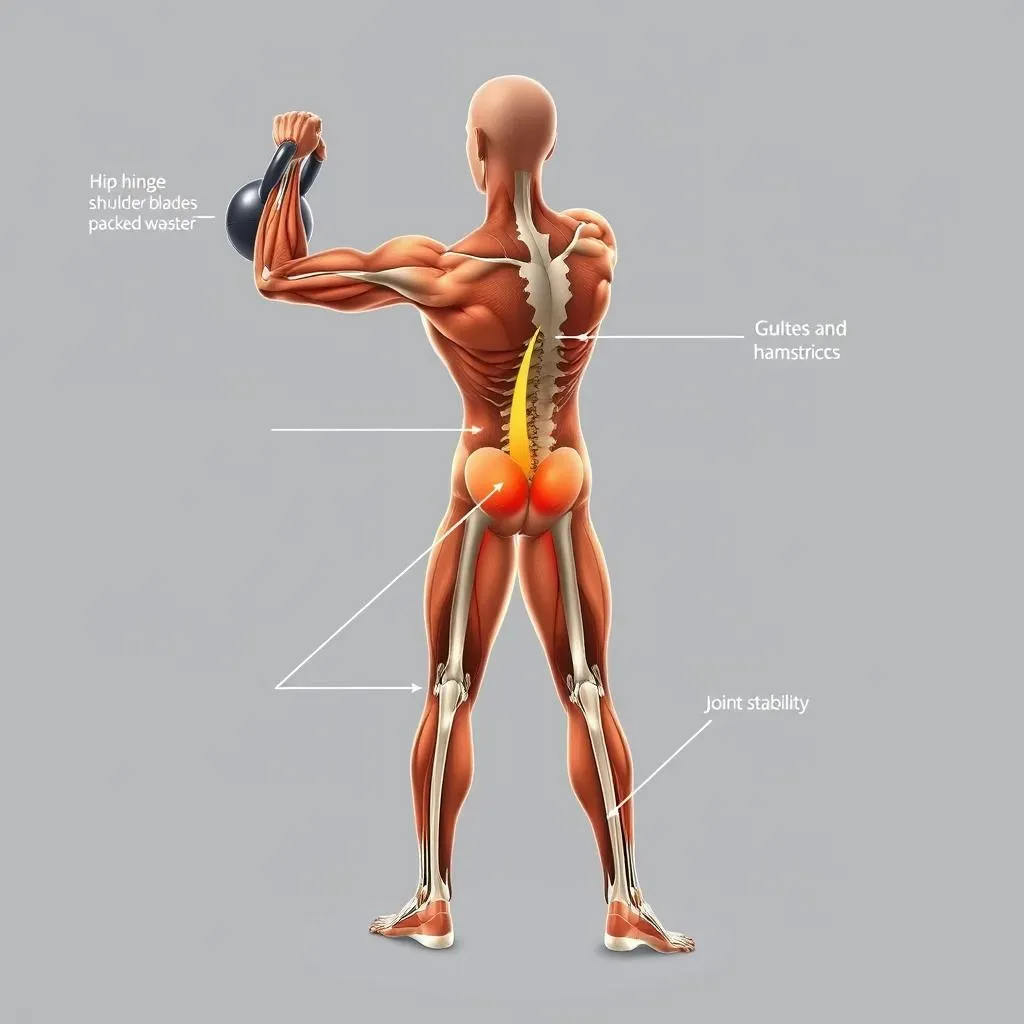Table of Contents
So, do kettlebell swings work shoulders? That's the million-dollar question, isn't it? You're probably here because you're curious about adding kettlebell swings to your workout, maybe to build some serious shoulder strength, or perhaps you're a bit worried about potential injuries. Let's be real, the internet is full of conflicting information. Some fitness gurus swear by kettlebell swings for shoulder health, while others warn against them, painting a picture of rotator cuff doom. This article cuts through the noise. We will explore exactly which muscles kettlebell swings target (hint: it's not just your glutes and hamstrings), and how they can benefit your shoulders when performed correctly. We'll also dive into proper technique to keep your shoulders safe and injury-free. Plus, we'll examine different kettlebell swing variations to target specific shoulder muscles and show you how to integrate them into a well-rounded, shoulder-friendly workout routine. By the end, you'll have a clear understanding of whether kettlebell swings are right for your shoulder goals, and how to make them work for you, not against you.
Muscles Worked During Kettlebell Swings: Shoulders and Beyond

Muscles Worked During Kettlebell Swings: Shoulders and Beyond
The Primary Movers: More Than Just a Hinge
so when most people think kettlebell swings, they immediately picture glutes and hamstrings, right? And they're not wrong! The swing is fundamentally a hip-hinge movement, which means your posterior chain is doing the heavy lifting. But let's not forget about the supporting cast, especially the unsung heroes of the shoulder girdle. Your shoulders are crucial for controlling the kettlebell throughout the entire movement. They stabilize the joint, guide the kettlebell's trajectory, and prevent it from flying off into next week.
Think of it this way: your lower body generates the power, but your upper body, including your shoulders, acts as the steering wheel. The deltoids (the main muscle of your shoulder) are engaged isometrically, meaning they're contracting to hold the kettlebell in place rather than actively lifting it. The rotator cuff muscles (supraspinatus, infraspinatus, teres minor, and subscapularis) are working overtime to keep your shoulder joint stable and prevent injury. This is especially true at the top of the swing when the kettlebell is at its highest point.
Beyond the Basics: Delving Deeper into Shoulder Engagement
Now, let's get a little more specific about how different parts of your shoulder are activated during the swing. The anterior deltoid (the front part of your shoulder) assists in raising the arm, especially as you reach the top of the swing. The lateral deltoid (the side of your shoulder) helps with abduction, or moving your arm away from your body. And the posterior deltoid (the back of your shoulder) plays a role in shoulder extension and external rotation, helping to control the kettlebell as it swings back down.
Furthermore, muscles like the trapezius and rhomboids, which connect your shoulder blades to your spine, are also engaged. They work to stabilize your scapula (shoulder blade) and prevent it from winging out or moving excessively during the swing. Strong scapular control is essential for maintaining proper shoulder mechanics and preventing impingement or other shoulder issues. So, while kettlebell swings may not be the ultimate shoulder-building exercise, they definitely contribute to overall shoulder strength, stability, and coordination.
Muscle Group | Role in Kettlebell Swing |
|---|---|
Deltoids (Anterior, Lateral, Posterior) | Isometric stabilization, assisting in arm elevation and control |
Rotator Cuff | Shoulder joint stabilization |
Trapezius & Rhomboids | Scapular stabilization |
Benefits of Kettlebell Swings for Shoulder Health and Strength

Benefits of Kettlebell Swings for Shoulder Health and Strength
Enhanced Shoulder Stability: The Foundation of Strength
so we've established that kettlebell swings engage your shoulder muscles. But what does that actually *mean* for your shoulder health? Well, one of the biggest benefits is improved shoulder stability. Remember those rotator cuff muscles we talked about? Kettlebell swings, when done right, can help strengthen these crucial stabilizers. Think of it like this: your rotator cuff is like the suspension system in your car. If it's weak or unstable, your ride is going to be bumpy, and you're more likely to experience problems down the road. By strengthening your rotator cuff, you're building a solid foundation for all your other shoulder movements, whether it's lifting weights, playing sports, or just reaching for that jar of pickles on the top shelf.
Strengthening the shoulder stabilizers can improve overall joint function and mitigate the risk of injuries. Kettlebell swings can be a valuable tool in a comprehensive shoulder care program.
Improved Posture and Scapular Control: Say Goodbye to Slouching
Another awesome benefit of kettlebell swings is their positive impact on posture and scapular control. In today's world, where many of us spend hours hunched over computers or staring at our phones, poor posture is practically an epidemic. Kettlebell swings can help counteract this by strengthening the muscles that pull your shoulders back and down, promoting a more upright and aligned posture. This is where those trapezius and rhomboid muscles come into play again. By strengthening these muscles, you're essentially retraining your body to maintain a better posture, which can alleviate neck and shoulder pain, improve breathing, and even boost your confidence. Think of it as a natural, built-in posture corrector that also happens to be a killer workout!
Also, better posture can lead to decreased risk of shoulder impingement and injury.
Benefit | Description |
|---|---|
Shoulder Stability | Strengthens rotator cuff muscles, improving joint function and reducing injury risk. |
Posture Correction | Strengthens muscles that promote upright posture, alleviating neck and shoulder pain. |
Scapular Control | Enhances shoulder mechanics, preventing impingement and improving overall shoulder health. |
Enhanced Proprioception: Knowing Where Your Shoulders Are in Space
Proprioception is your body's ability to sense its position and movement in space. It's like having an internal GPS system that tells you where your limbs are without you having to look at them. Kettlebell swings can significantly improve proprioception in your shoulders. The dynamic nature of the exercise, combined with the constant need for stabilization and control, challenges your nervous system to become more aware of your shoulder joint's position and movement patterns. This heightened awareness can translate to better coordination, improved balance, and a reduced risk of injury, not just in your shoulders, but throughout your entire body.
Enhanced proprioception can lead to better coordination and balance, and a reduced risk of injury, not just in your shoulders, but throughout your entire body.
Kettlebell Swing Technique: Protecting Your Shoulders

Kettlebell Swing Technique: Protecting Your Shoulders
Mastering the Hip Hinge: The Foundation of a Safe Swing
Alright, so you're ready to swing some kettlebells? Awesome! But before you go all out, let's talk technique, because this is where things can go south real quick if you're not careful. The most crucial aspect of a safe and effective kettlebell swing is the hip hinge. This is *not* a squat. Instead, you're pushing your hips back like you're trying to close a car door with your butt. Your back should stay straight, your core engaged, and your shoulders relaxed. Think of your arms as ropes connecting the kettlebell to your body. They shouldn't be actively lifting or pulling; all the power should be coming from your hips and glutes.
A proper hip hinge ensures that the posterior chain (glutes, hamstrings, and back) is doing the bulk of the work, minimizing stress on your shoulders. If you're feeling the swing primarily in your shoulders, it's a sign that you're not hinging correctly and need to dial it back and focus on the movement pattern.
Scapular Stability and Packing: Keeping Your Shoulders in Check
Now that you've nailed the hip hinge, let's talk about scapular stability. This is all about keeping your shoulder blades in the right position throughout the swing. Think of "packing" your shoulders, which means pulling your shoulder blades down and back as if you're trying to tuck them into your back pockets. This creates a stable base for your shoulder joint and prevents excessive movement or impingement. You should maintain this packed position throughout the entire swing, even at the top when the kettlebell is at its highest point. Avoid shrugging your shoulders up towards your ears, as this can lead to neck and shoulder pain.
Maintaining scapular stability prevents excessive movement or impingement, reducing the risk of shoulder injuries.
Technique Element | Description | Benefit |
|---|---|---|
Hip Hinge | Push hips back, keep back straight, engage core. | Minimizes shoulder stress. |
Scapular Packing | Pull shoulder blades down and back. | Creates a stable shoulder base. |
Arm Relaxation | Keep arms relaxed like ropes. | Prevents unnecessary shoulder strain. |
Kettlebell Swing Variations: Targeting Specific Shoulder Muscles

Kettlebell Swing Variations: Targeting Specific Shoulder Muscles
Tweaking the Swing: Isolating Different Shoulder Areas
so you've got the basic kettlebell swing down. Now, let's spice things up and target those shoulder muscles even more specifically with some variations! While the standard swing is great for overall shoulder stability, these tweaks can help you focus on different areas of your deltoids and rotator cuff. Think of it like fine-tuning your workout to sculpt those shoulders exactly how you want them. Remember, always prioritize proper form over weight when trying these variations. It's better to start light and master the movement before going heavy and risking injury.
Single-Arm Kettlebell Swings: Engaging the Stabilizers
First up, we've got single-arm kettlebell swings. This variation is a game-changer for shoulder stability. By holding the kettlebell in just one hand, you're forcing your shoulder stabilizers to work overtime to prevent rotation and maintain balance. This is especially beneficial for strengthening the rotator cuff muscles, which are essential for preventing shoulder injuries. Start with a lighter weight than you would use for a two-handed swing, and focus on keeping your torso square and preventing any twisting or leaning. You should feel a significant burn in your shoulder muscles after just a few reps.
Single-arm swings are great, but make sure to keep the weight lighter than your usual two-handed swing. This variation is all about control and stability, not brute strength.
American Kettlebell Swings: More Shoulder Involvement?
Next, let's talk about American kettlebell swings. In this variation, you swing the kettlebell all the way overhead, instead of just to chest height like in the Russian swing. This increases the range of motion and requires more shoulder flexion, which can further engage the anterior deltoid. However, it's important to note that American swings are a bit controversial. Some experts believe that swinging the kettlebell overhead can put excessive stress on the shoulder joint, especially if you have pre-existing shoulder issues. If you choose to try American swings, make sure you have excellent shoulder mobility and control, and start with a very light weight. Listen to your body, and stop immediately if you feel any pain.
Whether American swings are right for you depends on your individual shoulder health and mobility. If you have any doubts, stick to Russian swings or other shoulder-friendly variations.
Variation | Description | Targeted Muscles | Considerations |
|---|---|---|---|
Single-Arm Swing | Swing kettlebell with one hand. | Rotator cuff, deltoids (stabilization). | Use lighter weight, focus on torso stability. |
American Swing | Swing kettlebell overhead. | Anterior deltoid, trapezius. | Requires excellent shoulder mobility, potential for increased shoulder stress. |
Integrating Kettlebell Swings into a ShoulderFriendly Workout Routine

Integrating Kettlebell Swings into a ShoulderFriendly Workout Routine
Warm-Up Essentials: Preparing Your Shoulders for Action
Alright, let's talk about how to actually weave kettlebell swings into your workout plan without turning your shoulders into a pretzel. The key here is smart integration, and that starts with a solid warm-up. Don't even think about picking up a kettlebell until you've prepped your shoulders properly. This means dynamic stretches that get your blood flowing and your joints lubricated. Think arm circles (forward and backward), shoulder blade squeezes, and gentle resistance band exercises like external rotations and rows. The goal is to activate your rotator cuff muscles and improve your range of motion before you start swinging.
A proper warm-up is non-negotiable! It's like foreplay for your shoulders, getting them ready for the main event and preventing any unwanted strains or pulls.
Pairing Swings with Shoulder-Supportive Exercises: A Balanced Approach
Once you're warmed up, it's time to think about exercise pairings. Kettlebell swings shouldn't be the *only* thing you're doing for your shoulders. Instead, think of them as one piece of a larger puzzle. Pair them with exercises that directly target your rotator cuff muscles, like lateral raises, front raises, and reverse flyes. These exercises will help strengthen your shoulder stabilizers and improve your overall shoulder health. Also, don't forget about exercises that promote good posture and scapular control, like rows, face pulls, and YTWL raises. These will help counteract the hunched-over posture that many of us fall into and keep your shoulders in a healthy, aligned position.
Variety is the spice of life, and it's also the key to a well-rounded shoulder workout. Don't just swing and hope for the best; target all the different muscles and movements that contribute to shoulder health.
Exercise Type | Example Exercises | Benefit |
|---|---|---|
Dynamic Warm-up | Arm circles, shoulder blade squeezes, resistance band rotations | Prepares shoulders for activity, improves range of motion |
Rotator Cuff Strengthening | Lateral raises, front raises, reverse flyes | Strengthens shoulder stabilizers, prevents injury |
Posture Correction | Rows, face pulls, YTWL raises | Promotes good posture, improves scapular control |
Progressive Overload and Listening to Your Body: The Key to Long-Term Success
Finally, remember the golden rule of any workout program: progressive overload. This means gradually increasing the weight, reps, or sets over time as you get stronger. But with kettlebell swings, it's especially important to listen to your body and avoid pushing yourself too hard, too soon. Start with a lighter weight and focus on mastering the technique before adding more load. And if you ever feel any pain in your shoulders, stop immediately and assess the situation. It's always better to err on the side of caution and take a break than to push through pain and risk a serious injury. Kettlebell swings can be a fantastic tool for building shoulder strength and stability, but only if you approach them with patience, respect, and a healthy dose of self-awareness.
Your body is your best guide. Pay attention to its signals and adjust your workout accordingly. There's no shame in scaling back or taking a rest day when you need it.
Conclusion: Kettlebell Swings and Your Shoulders – A Powerful Partnership
Ultimately, whether kettlebell swings work shoulders in a positive way depends on you. They aren't a magic bullet for shoulder strength, nor are they inherently dangerous. When performed with proper technique, mindful progression, and integrated into a comprehensive fitness plan, kettlebell swings can contribute to shoulder stability, power, and overall functional fitness. Listen to your body, prioritize form over weight, and don't be afraid to seek guidance from a qualified professional. With the right approach, kettlebell swings can be a valuable tool in your quest for stronger, healthier shoulders.